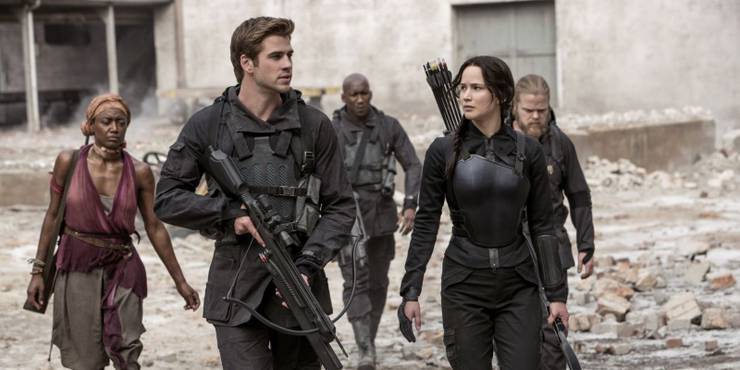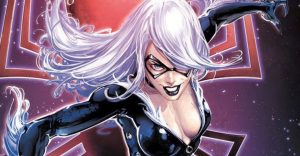Hunger Games: Every Major Difference Between The Movies & Books

The hugely popular The Hunger Games movie franchise was adapted from Suzanne Collins’s young adult book trilogy in 2012 and concluded in 2015 after four movies, including a two-part film adaptation of the third novel, Mockingjay; however, there are notable differences between the movies and the books. The Hunger Games quickly became one of the biggest and most influential Hollywood franchises in recent history, grossing $2.97 billion worldwide. Jennifer Lawrence’s performance as protagonist Katniss Everdeen be met by widespread acclaim, firmly establishing the young star as a household name; yet, her character is different in the movies than in the novels.
The movies brought together industry newcomers and veteran actors alike to round out their ensemble cast. The series feature Josh Hutcherson as Peeta Mellark, the other District 12 tribute and Katniss’ eventual love interest, Liam Hemsworth as Katniss’ childhood friend Gale Hawthorne, Woody Harrelson as District 12 victor Haymitch Abernathy, Elizabeth Banks as Effie Trinket, Stanley Tucci as Caesar Flickerman, and Donald Sutherland as President Snow.
The Hunger Games movies are broadly recognized by fans for being loyal to Collins’ novels; however, as is inevitable with any book-to-screen adaptation, the franchise did change some aspects of the book trilogy to accommodate the big-screen format and runtime. Leaving slight tweaks aside, what follows is every major difference between The Hunger Games movies and books.
The Hunger Games Movies Abandon the Mockingjay Pin Origin Story

Madge Undersee, the District 12 mayor’s daughter, does not appear at all in the movies. In the book, the famous mockingjay pin which Katniss wears as her tribute token in the Games, and which eventually becomes a symbol of the revolution, is given to her by Madge. In the movie, Katniss is receives the pin from a woman at the Hob – possibly Greasy Sae, though she is not named in the film – and later gives it to her younger sister Primrose as a good-luck charm, promising that nothing bad would happen to her so long as she had the pin. After Katniss volunteers as tribute in place of her sister, Prim returns the pin to her as protection during their emotional goodbye. Though the movie’s origin for the mockingjay pin establishes a close bond between the two sisters, the film does not address the symbol’s important backstory.
In the book, Katniss explains that the mockingjay is “something of a slap in the face” for the Capitol: during the last rebellion, the Capitol had created several genetically modified animals to use as weapons against insurgent districts. One of these was a bird called a jabberjay, which would fly out to the districts and listen in on rebels’ conversations, and then repeat these conversations to intelligence gatherers in the Capitol. However, when the rebels figured out the birds were spies, they started feeding them false intelligence to mislead the Capitol. After the uprising was quashed and the jabberjays were released into the wild, they mated with mockingbirds and created mockingjays. Though these hybrids cannot speak, they can repeat melodies and were therefore used to send signals — for instance, by the workers in Rue’s home district.
The book affords the mockingjay a much more meaningful origin story, one which adds to the symbol’s significance as its iconography is appropriated by the rebellion. It allows for a parallel to be drawn between the mockingjay and Katniss herself: she evolves from being paraded around by the Capitol as a propaganda tool to defying President Snow and becoming the face of the rebellion.
The Movie Villains Have More Depth & The Capitol Less Cruel

While the books are written from Katniss’ point of view, the films naturally allow for a broader perspective. The audience sees behind the scenes of the Games and spends more time with President Snow and Chief Gamemaker Seneca Crane than the books allowed for. It is interesting to see Crane interact with Snow, as viewers are pushed to consider that he may be as much at the mercy of the Capitol as anyone else. This perspective emphasizes that the Capitol is a delicate ecosystem in which everyone has a role to play for its existence to be maintained. Snow is allowed more depth, thanks in part to Sutherland’s charismatic performance. The films see him at home and in his office, sharing a meal with his granddaughter and growing visibly worried about Katniss’ influence. His control over the Capitol does not appear as ironclad in the movies, and the potential for a successful rebellion seems more accessible because the audience is privy to happenings beyond Katniss’ point of view.
The movies also remove some details of the books which emphasize the cruelty of those in power, particularly in the first novel. For instance, Katniss sees two people on the run in the woods while out hunting with Gale; she witnesses one of them be killed by a harpoon to the chest while the girl is trapped in a net dropped from a Peacekeeper hovercraft. When Katniss arrives in the Capitol, she recognizes one of the mute slaves as the same girl, whose tongue was cut out as punishment before she was enslaved.
Likewise, there is a major scene in The Hunger Games which sees Katniss and Peeta attacked by dog-like creatures in the arena. In the book, these “Mutts” are made from the DNA of the dead Tributes, including Katniss’ friend Rue, and therefore shared their physical features. In the movie however, these mutts are little more than glorified attack dogs. The film adaptation therefore does not show the most emotionally manipulative dimensions of what the Gamekeepers throw at the Tributes, which worked in the novels to highlight the mercilessness of those in power.
Movie Katniss Is Given More Agency In Choosing Her Role As Leader

In The Hunger Games: Mockingjay – Part 2, Katniss sneaks to the Capitol to assassinate President Snow and to help the District 13 rebels, all without authorization from those in charge. Explaining that she is in no shape to fight and too valuable to lose in combat, Coin had previously ordered Katniss to continue shooting propaganda films, where she could keep an eye on her and ensure no harm came to the revolution’s poster girl.
In the books, Katniss and Johanna are trained extensively in District 13 so that they can be cleared for the field. Katniss is only able to accompany the mission to the Capitol after asking permission from Plutarch and Coin, and only so she can be the televised face of the uprising. The movie version therefore gives Katniss more agency in her role as revolutionary leader, as she actively refuses to again be used as a propaganda tool and decides instead to take the fate of the revolution in her own hands. The movie version of events also underscores that Katniss is impossible to control, which sets precedent for the future conflicts between her and Coin’s ambitions. The audience also gets to see the effect that Katniss’ disobedience has on the District 13 leader. She is furious at Katniss’ defiance, which adds credence to later indications that Coin wants Katniss dead so that she can use her as a martyr for the cause.
The movies work to make Katniss appear less like a tool used by others for their own gain, and more like a heroine who refuses to sit idly by and is purer of heart than the politicians she is surrounded by. This makes her easier to root for, which is likely the same reason why the filmmakers cut a pivotal scene from the final book in which Katniss shoots a civilian in cold blood. By The Hunger Games franchise’s conclusion, Katniss was closer to classic ideas of a Hollywood heroine than she was in the novels.
About The Author

















